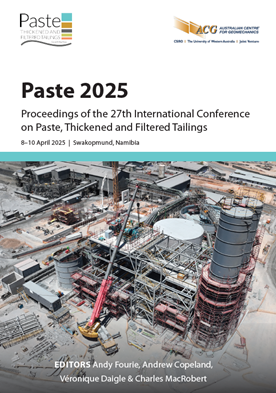Preliminary framework for filtered tailings deposition design considerations: a South African perspective

|
Authors: Roux, K; MacRobert, C; Roux, N |
DOI https://doi.org/10.36487/ACG_repo/2555_06
Cite As:
Roux, K, MacRobert, C & Roux, N 2025, 'Preliminary framework for filtered tailings deposition design considerations: a South African perspective', in AB Fourie, A Copeland, V Daigle & C MacRobert (eds), Paste 2025: Proceedings of the 27th International Conference on Paste, Thickened and Filtered Tailings, Australian Centre for Geomechanics, Perth, pp. 105-120, https://doi.org/10.36487/ACG_repo/2555_06
Abstract:
As global mining operations increasingly adopt filtered stack tailings (FST) deposition technology, the need for a design consideration framework becomes evident. To an extent this gap was filled in March 2024 when the BHP Rio Tinto Tailings Management Consortium's recommended approach to filtered tailings system design was published. For a South African context this gap still prevails as limited literature has been published on this topic and the implementation of the FST technology is still immature. The proposed framework is therefore aligned to South Africa’s unique environmental, regulatory, and geotechnical conditions. The framework addresses key challenges in FST implementation, including material characterisation, site-specific conditions, technology selection (filtration, transportation and stacking), as well as environmental and regulatory considerations. Filtered tailings offer a sustainable alternative to conventional wet tailings storage facilities by enhancing water recovery and reducing environmental risks. However, large-scale adoption in South Africa remains limited due to high capital costs, technical barriers, and a lack of standardised methodologies. This preliminary framework aims to bridge these gaps by aligning global best practices with local parameters to guide tailings design engineers in evaluating and implementing FST systems. The framework aims to facilitate informed decision-making through design consideration guidelines, promoting environmentally sound and structurally robust tailings management practices. By supporting trade-off analyses between different deposition methodologies, this research advances sustainable mining practices in South Africa while contributing to the global discourse on tailings management innovation.
Keywords: filtered stacked tailings, dry stack, framework, material characteristics, design evaluation
References:
BHP Rio Tinto 2024, Filtered Stacked Tailings A Guide for Study Managers, 1st edn, BHP Rio Tinto Tailings Management Consortium.
Cacciuttolo, C & Atencio, E 2023, ‘Dry stacking of filtered tailings for large-scale production rates over 100,000 metric tons per day: envisioning the sustainable future of mine tailings storage facilities’, Minerals, vol. 13, no. 11,
Copeland, A, Daigle, V & Strauss, A 2023, ‘Is the implementation of dry stacking for tailings storage increasing? A Southern African perspective’, in GW Wilson, NA Beier, DC Sego, AB Fourie & D Reid (eds), Paste 2023: Proceedings of the 25th International Conference on Paste, Thickened and Filtered Tailings, University of Alberta, Edmonton, and Australian Centre for Geomechanics, Perth, pp. 611–619,
Copeland, AM, Lyell, KA & van Greunen, P 2006, ‘Disposal of belt filtered tailings – skorpion zinc case study: feasibility, design and early operation’, in R Jewell, S Lawson & P Newman (eds), Paste 2006: Proceedings of the Ninth International Seminar on Paste and Thickened Tailings, Australian Centre for Geomechanics, Perth, pp. 243–254,
Copeland, AM & Teixeira, JM 2019, ‘Design of coarse tailings and dry ash disposal facilities’, in AJC Paterson, AB Fourie & D Reid (eds), Paste 2019: Proceedings of the 22nd International Conference on Paste, Thickened and Filtered Tailings, Australian Centre for Geomechanics, Perth, pp. 101–114,
Copeland, A & Zannoni, E 2024, ‘Risk and informed approach to TSF design and operation’, SAICE Civil Engineering, vol. 4, pp. 13–16.
Davies, M 2011, ‘Filtered dry stacked tailings-the fundamentals’, Proceedings of Tailings and Mine Waste 2011, University of British Columbia, Vancouver.
Dladla, SD & Ramsamy, S 2022, ‘Practical steps to global industry standard on tailings management (GISTM) compliance for operational tailings storage facilities in South Africa’, The Journal of the Southern African Institute of Mining and Metallurgy, vol. 122, no. 6,
Grant-Stuart, DJ 2020, Your Tailings Dam, The South African National Committee on Large Dams, Pretoria.
Inci, YS, Uzunçelebi, G, Ürkmez, H, Ennis, S, Kimball, P & Ruiz Castro, E 2023, ‘Application of filtered tailings storage method at Tüprag Efemçukuru Gold Mine’, in GW Wilson, NA Beier, DC Sego, AB Fourie & D Reid (eds), Paste 2023: Proceedings of the 25th International Conference on Paste, Thickened and Filtered Tailings, University of Alberta, Edmonton, and Australian Centre for Geomechanics, Perth, pp. 354–371,
Küpper, AG, Van Zyl, D & Thompson, JFH 2020, ‘Mine tailings-a systems approach’, in B Oberle, D Brereton & A Mihaylova (eds), Towards Zero Harm: A Compendium of Papers Prepared for the Global Tailings Review, Global Tailings Review, St Gallen,
MacRobert, CJ, Wates, J, Coetzee, A & Howell, G 2022, ‘GISTM: Who are the responsible individuals?’, The Journal of the Southern African Institute of Mining and Metallurgy, vol. 122, no. 6,
Patterson, K, Piggott, M-J & Casey, J 2020, ‘Tailings facility design and advancements in tailings technologies’, in R Furey & JF Lupo (eds), Mine Tailings : Perspectives for a Changing World, Society for Mining, Metallurgy & Exploration, pp. 133–139.
Republic of South Africa 1996, Mine Health and Safety Act 29 of 1996, Pretoria.
South African Bureau of Standards 1998, SANS 10286 Management of Mine Residue, Pretoria.
Vietti, AJ & van der Linde, C 2024, ‘A model for understanding dispersive clay behaviour for tailings solid/liquid separation applications’, Physical Separation ’24, MEI Conferences, Cornwall.
Warburton, M, Hart, S, Ledur, J, Scheyder, E & Levine, AJ 2020, The Looming Risk of Tailings Dams, Reuter Graphics,
Weinert, HH 1980, The Natural Road Construction Materials of Southern Africa, 1st edn, Academica, Pretoria.
© Copyright 2025, Australian Centre for Geomechanics (ACG), The University of Western Australia. All rights reserved.
View copyright/legal information
Please direct any queries or error reports to repository-acg@uwa.edu.au
View copyright/legal information
Please direct any queries or error reports to repository-acg@uwa.edu.au
